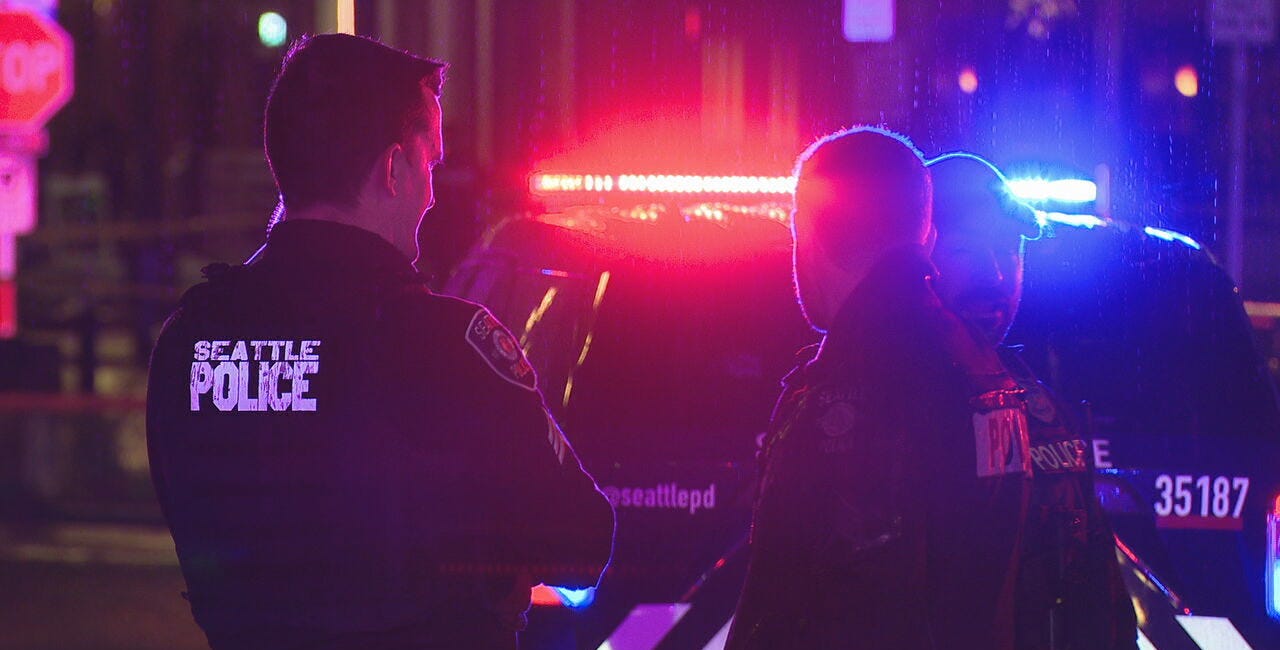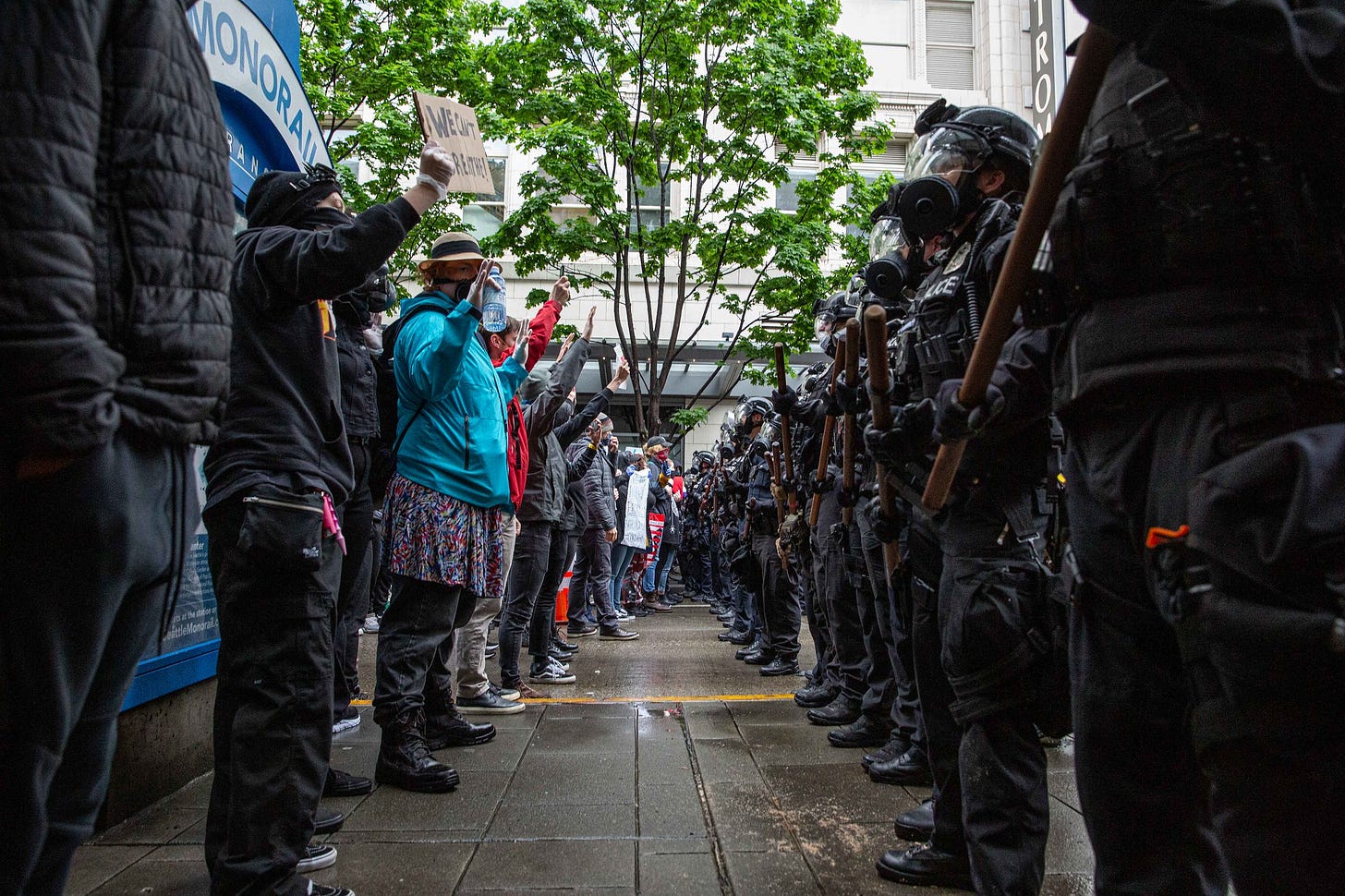Still shouting 'Defund SPD' five years later
BY JUSTIN WARD
Five years ago, I was standing on the street at 11th Ave and Pine, where thousands of people had faced off against a horde of police officers the previous week. Every day, they gassed us, pepper-sprayed us, and shot rubber bullets at us, but that was over.
The Seattle Police Department had just evacuated the East Precinct, and people were in the streets celebrating. The moment felt revolutionary. Together, we stood up to a well-armed, militarized police force, and they blinked.
Folks were giving speeches through a sound system. There was a lot of talk about what to do with the newly abandoned precinct. Some suggested turning it into a community center, while others said we should cede it to the Duwamish.
Then a young Black woman got up and gave us a reality check. She asked: “What have we won?”
She was right. We hadn’t defunded the police, nor had we secured justice for the scores of people the Seattle police killed over the last two decades. Not a single officer had been held accountable for the violence they inflicted on us over the previous days. And we hadn’t gotten funding to stand up police alternatives, address root causes, or build badly needed housing.
All we had were our big dreams and a boarded-up precinct — and we didn’t really have that. SPD took it back a few weeks later.
Backlash Blues
Back then, it was easy to get caught up in the feeling that anything was possible. With all that momentum, we were sure we would win. The Seattle police believed it, too. They were scrambling to draw up contingency plans for a 50 percent cut.
We all know how the rest of this story goes. The protests gradually wound down, and they had all but disappeared by mid-2021. Mayor Jenny Durkan passed a less than 3 percent cut to the police budget, but slashed spending on other departments by even more. Most of the city council members who pledged support for deep cuts walked that back, and an attempt to elect two abolitionists to the city council and the city attorney’s office, respectively, fell short.
The election marked a decisive shift toward law-and-order politics. In 2022, Republican Ann Davison took over as city attorney while small business tyrant Sara Nelson defeated abolitionist Nikkita Oliver for a citywide council seat. And of course, Chamber of Commerce champion Bruce Harrell became the mayor, with a mandate from the business community to rein in disorder downtown.
It was clear how far the pendulum had swung in only a year. Like many cities, Seattle saw a spike in violent crime during and immediately after the COVID-19 pandemic. Homicides hit a 20-year high in 2023. Suddenly, the so-called staffing crisis at SPD was practically the only issue that anyone seemed to care about. Every newspaper, TV station, and blog was crying out for more cops.
Capitalizing on that sentiment, Harrell remade the city council in his own image. Seattle swapped out two progressives and the council’s only socialist for hand-picked pro-cop centrists. One by one, anyone who had previously so much as entertained the idea of defunding the police was replaced.
Is Defund Dead?
Given the total rejection of defunding the police at the ballot box here in Seattle and in the broader discourse nationwide, one might argue that the idea is now a total nonstarter. It’s treated as a fever dream — some madness that took hold during the pandemic we’ve collectively snapped out of.
However, it’s as correct today as it was in 2020. For starters, the push for more cops was primarily driven by the belief that there was a connection between the so-called staffing shortage and the rise in crime from 2020 to 2023. We now know that this is false.
In 2024, Seattle’s violent crime rate was lower than it was in 2018, when SPD had 400 more officers, and the rate continues to drop at an incredible pace in 2025. This mirrors trends across the country. So-called murder capitals like Baltimore, St. Louis, and Chicago have seen dramatic declines in homicides and shootings despite police staffing that is supposedly at a crisis level.
Nationwide, violent crime is reverting to below pre-pandemic levels. In particular, Baltimore has achieved incredible results. This city, whose association with gun violence was cemented in fictional portrayals like The Wire, has had fewer homicides so far this year than in any year since 1966.
Mayor Brandon Scott attributes this to community-based violence interruption programs and a multi-department effort to stop shootings. St. Louis, which consistently has some of the highest murder rates in the country, has also realized similar public safety gains, posting double-digit drops in homicides every year of Mayor Tishuara Jones’ tenure. In her first year, Mayor Jones reappropriated money from the police budget to address root causes and establish the Office of Violence Prevention.
In Seattle, we’re spending more on cops than ever. Last year, while the city faced a $250 million deficit, Mayor Harrell bumped the police budget by $60 million and gave officers a whopping 23 percent raise. To pay for it all, the mayor raided JumpStart, a progressive revenue source designed to fund housing.
Meanwhile, the city’s homeless population continues to grow while hundreds die on the street from violence, drug overdoses, and preventable disease annually. If the city had spent it on its intended purpose, the $277 million taken from JumpStart would go a long way to addressing these issues. It could tackle the root causes of crime and disorder in a more meaningful and impactful way than police ever could.
A Zero-Sum Game
In 2020, we struggled to expand the definition of public safety beyond policing. We argued that, instead of spending millions on massive overtime costs and emphasis patrols, the city would get a better return by hiring more case workers, expanding drug treatment, and scaling up violence interruption.
This was treated as pie in the sky. We were told the answer was not to defund but to “reimagine” the police. Better training, higher standards, more “accountability”—it all boiled down to more money for cops.
They told us that it wasn’t an “either-or” but a “yes-and” situation, that we could find money to fund all those things and pay for the police department. Yet, city budgets are a zero-sum game. Unless Seattle drastically increases revenue through taxes, which is something the city seems loath to do, then you need to take money from one column and put it in the other.
The extended version of our slogan was “Defund SPD by 50 Percent At Least.” At a time when politicians, the media, and the general public began to abandon our movement, a city-commissioned study came along and validated its fundamental premise.
In 2021, the National Institute for Criminal Justice Reform found that around 80 percent of 911 calls for service were for non-criminal matters. Only about 6 percent involved felony crimes. What’s more, 50 percent of call types, including several of the most common calls, could be safely handled by a non-police response.
In other words, defunding the police is hardly a pipe dream. By shifting most calls to first responders who are better trained, educated, and equipped than police officers, the city could easily cut the SPD budget in half, if not more.
So why didn’t we? While Los Angeles, Portland, Denver, and other cities were building alternative responses, Seattle’s efforts stalled. Finally, the city put together the CARE team, the “third public safety department,” in 2023.
The fact that CARE was poorly funded and understaffed from the start was the least of its problems. The police guild hobbled CARE and prevented it from taking more than 1 percent of calls—a far cry from the majority of calls envisioned by the NICJR report.
If the police guild were truly concerned about its overworked officers or improving public safety, it would have given its blessing for alternative responses to expand, like other police associations have. Instead, it intends to maintain its monopoly on public safety to leverage ever-increasing concessions on wages and accountability.
The result will be that the police will continue to gobble up more and more city revenue, even in lean times, while the city will have no choice but to make cuts to vital city departments.
I’m still saying “Defund SPD” five years after the George Floyd protests because one thing is as true today as it was back then: Either we defund the police, or the police defund us.







5 years ago, I was saying defund. Today, I’m saying abolish.